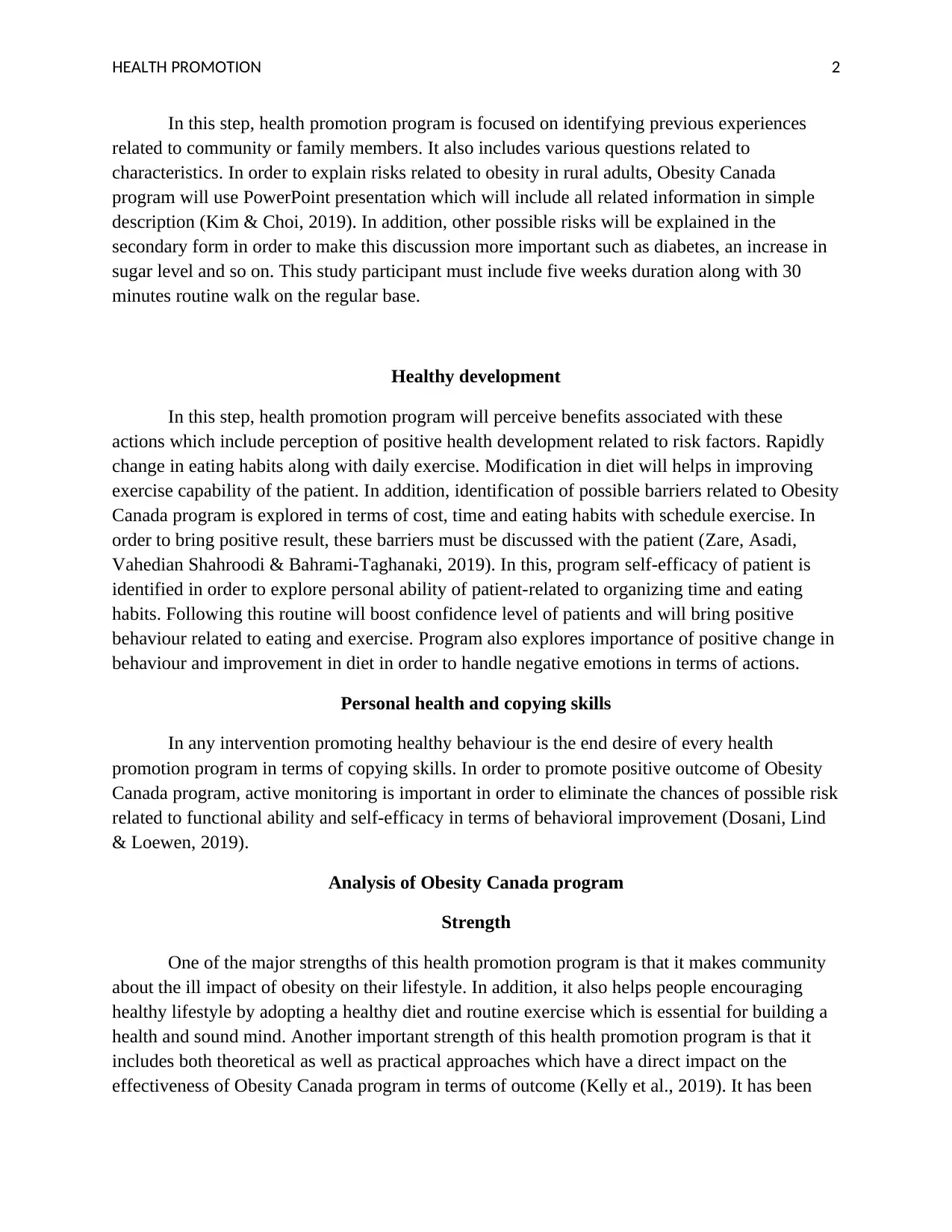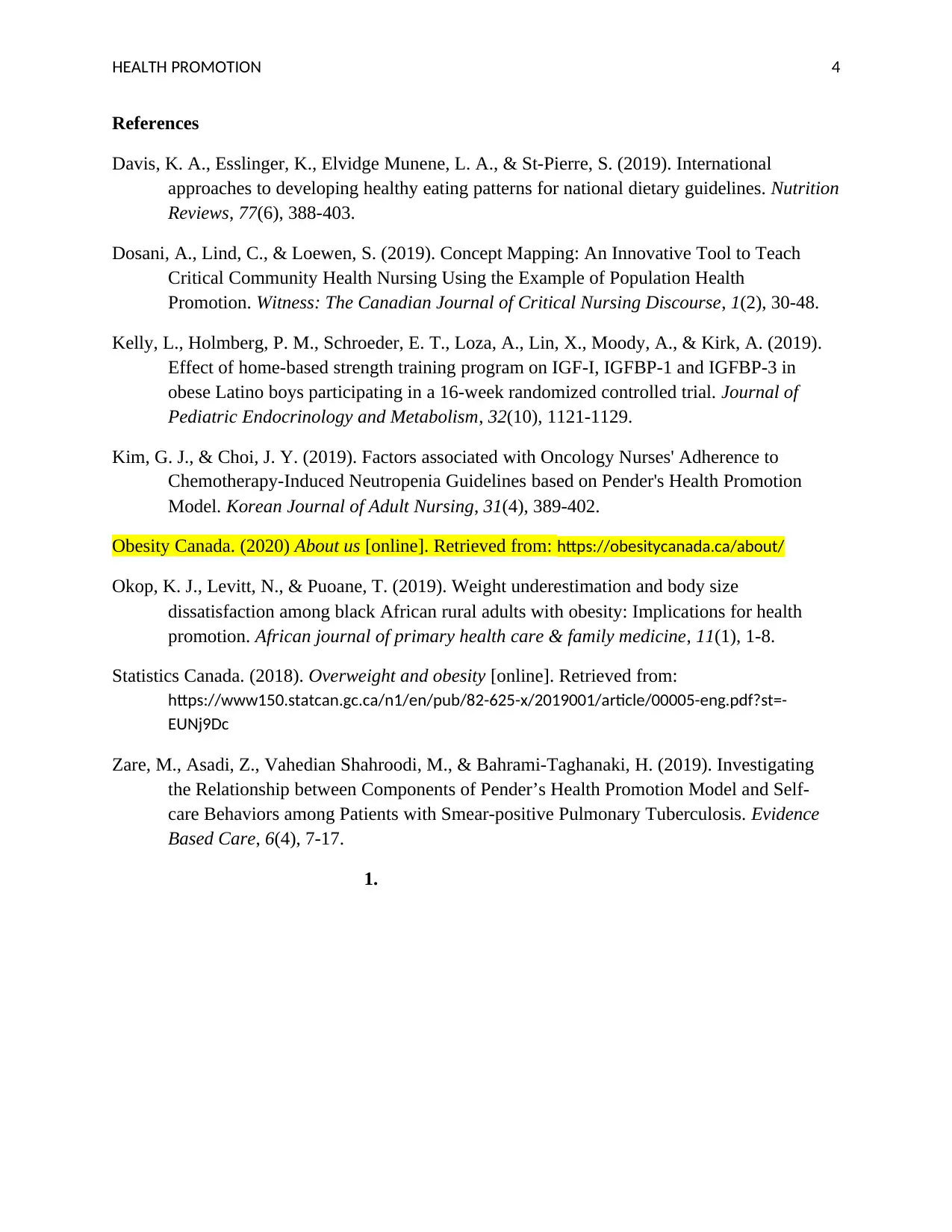HLSC 3002: Health Promotion Report - Obesity Canada Analysis
VerifiedAdded on 2022/08/13
|6
|1582
|8
Report
AI Summary
This report provides a critical analysis of the Obesity Canada health promotion program, which aims to address the growing issue of obesity in Canada, particularly among young adults. The program's objectives, target population, and services are outlined, emphasizing its focus on raising awareness about the adverse effects of obesity. The analysis applies the Population Health Promotion Model, examining the program's strategies across different levels of action, including education and personal health practices. The report identifies the program's strengths, such as its community support and two-way communication, while also pointing out unintended gaps, such as the lack of cost-effective solutions. The program's effectiveness is evaluated by considering its impact on the target audience and its potential for long-term success, highlighting the importance of a healthy lifestyle through diet and exercise.

Running Head: HEALTH PROMOTION
Health promotion
Report
Student Name
[Pick the date]
Health promotion
Report
Student Name
[Pick the date]
Paraphrase This Document
Need a fresh take? Get an instant paraphrase of this document with our AI Paraphraser

HEALTH PROMOTION 1
Critical Analysis: Obesity Canada Programming for young adults
Obesity invites a lot of health problems in rural adults and old rural adults and has
impacted their professional as well as personal life. In order to resolve this issue, Canada
government has introduced a health promotion program to decrease percentage of obesity in the
Canadian community under the name “Obesity Canada” (Obesity Canada, 2020). The objective
of this health promotion program is to address the key issue/priority of growing obesity in
Canada and the services offered by this program is to make people aware of the ill effect of
obesity on their life. The intended target population of this program includes young adults which
are forming 64% of population and are suffering from this obesity disease (Statistics Canada,
2018).
This initiative was praised by various communities which are facing obesity problem and
has impacted their overall lifestyle, especially rural adults. In addition, this health promotion
program was also associated with believe that obesity must be treated like other medical diseases
that require prevention and treatment.
Level of action
At present obesity has become one of the leading health problems on the global level. It
has been found that almost 64% of people who are above 18 years are suffering from this health
problem in Canada. Canadian Medical Association has declared obesity as one of the chronic
health burdens on Canada due to which different level of action are taken in obesity Canada
program. In January 2019, Obesity Canada program focused their interest in promoting a revised
food guide which included guidelines for promoting healthy eating habits with maintenance of a
balance diet full of nutrition's (Davis et al., 2019). In addition, Obesity Canada program explored
that in adult community high body index is leading factor that promotes obesity which results in
partial disability and death in some cases. It considered Obesity as a risk factor instead of chronic
health disease. This health promotion program is mainly focused on rural adults who are
studying or work professional community of Canada because the percentage of obesity is
continuously increasing in this section of the community.
Population Health promotion model
Health promotion (HP) model believes that every individual has unique personal
characteristics along with experience which indicate their possible actions (Okop, Levitt, &
Puoane, 2019). As per this program, there are various DOHS which are covered in this model
such as education, health service, individual characteristics, culture support and behaviour
aspects HP model is used for Obesity Canada program which is mainly focuses on three areas
which are education and personal health practice, personal health and copying skills.
Education and personal health practice
Critical Analysis: Obesity Canada Programming for young adults
Obesity invites a lot of health problems in rural adults and old rural adults and has
impacted their professional as well as personal life. In order to resolve this issue, Canada
government has introduced a health promotion program to decrease percentage of obesity in the
Canadian community under the name “Obesity Canada” (Obesity Canada, 2020). The objective
of this health promotion program is to address the key issue/priority of growing obesity in
Canada and the services offered by this program is to make people aware of the ill effect of
obesity on their life. The intended target population of this program includes young adults which
are forming 64% of population and are suffering from this obesity disease (Statistics Canada,
2018).
This initiative was praised by various communities which are facing obesity problem and
has impacted their overall lifestyle, especially rural adults. In addition, this health promotion
program was also associated with believe that obesity must be treated like other medical diseases
that require prevention and treatment.
Level of action
At present obesity has become one of the leading health problems on the global level. It
has been found that almost 64% of people who are above 18 years are suffering from this health
problem in Canada. Canadian Medical Association has declared obesity as one of the chronic
health burdens on Canada due to which different level of action are taken in obesity Canada
program. In January 2019, Obesity Canada program focused their interest in promoting a revised
food guide which included guidelines for promoting healthy eating habits with maintenance of a
balance diet full of nutrition's (Davis et al., 2019). In addition, Obesity Canada program explored
that in adult community high body index is leading factor that promotes obesity which results in
partial disability and death in some cases. It considered Obesity as a risk factor instead of chronic
health disease. This health promotion program is mainly focused on rural adults who are
studying or work professional community of Canada because the percentage of obesity is
continuously increasing in this section of the community.
Population Health promotion model
Health promotion (HP) model believes that every individual has unique personal
characteristics along with experience which indicate their possible actions (Okop, Levitt, &
Puoane, 2019). As per this program, there are various DOHS which are covered in this model
such as education, health service, individual characteristics, culture support and behaviour
aspects HP model is used for Obesity Canada program which is mainly focuses on three areas
which are education and personal health practice, personal health and copying skills.
Education and personal health practice

HEALTH PROMOTION 2
In this step, health promotion program is focused on identifying previous experiences
related to community or family members. It also includes various questions related to
characteristics. In order to explain risks related to obesity in rural adults, Obesity Canada
program will use PowerPoint presentation which will include all related information in simple
description (Kim & Choi, 2019). In addition, other possible risks will be explained in the
secondary form in order to make this discussion more important such as diabetes, an increase in
sugar level and so on. This study participant must include five weeks duration along with 30
minutes routine walk on the regular base.
Healthy development
In this step, health promotion program will perceive benefits associated with these
actions which include perception of positive health development related to risk factors. Rapidly
change in eating habits along with daily exercise. Modification in diet will helps in improving
exercise capability of the patient. In addition, identification of possible barriers related to Obesity
Canada program is explored in terms of cost, time and eating habits with schedule exercise. In
order to bring positive result, these barriers must be discussed with the patient (Zare, Asadi,
Vahedian Shahroodi & Bahrami-Taghanaki, 2019). In this, program self-efficacy of patient is
identified in order to explore personal ability of patient-related to organizing time and eating
habits. Following this routine will boost confidence level of patients and will bring positive
behaviour related to eating and exercise. Program also explores importance of positive change in
behaviour and improvement in diet in order to handle negative emotions in terms of actions.
Personal health and copying skills
In any intervention promoting healthy behaviour is the end desire of every health
promotion program in terms of copying skills. In order to promote positive outcome of Obesity
Canada program, active monitoring is important in order to eliminate the chances of possible risk
related to functional ability and self-efficacy in terms of behavioral improvement (Dosani, Lind
& Loewen, 2019).
Analysis of Obesity Canada program
Strength
One of the major strengths of this health promotion program is that it makes community
about the ill impact of obesity on their lifestyle. In addition, it also helps people encouraging
healthy lifestyle by adopting a healthy diet and routine exercise which is essential for building a
health and sound mind. Another important strength of this health promotion program is that it
includes both theoretical as well as practical approaches which have a direct impact on the
effectiveness of Obesity Canada program in terms of outcome (Kelly et al., 2019). It has been
In this step, health promotion program is focused on identifying previous experiences
related to community or family members. It also includes various questions related to
characteristics. In order to explain risks related to obesity in rural adults, Obesity Canada
program will use PowerPoint presentation which will include all related information in simple
description (Kim & Choi, 2019). In addition, other possible risks will be explained in the
secondary form in order to make this discussion more important such as diabetes, an increase in
sugar level and so on. This study participant must include five weeks duration along with 30
minutes routine walk on the regular base.
Healthy development
In this step, health promotion program will perceive benefits associated with these
actions which include perception of positive health development related to risk factors. Rapidly
change in eating habits along with daily exercise. Modification in diet will helps in improving
exercise capability of the patient. In addition, identification of possible barriers related to Obesity
Canada program is explored in terms of cost, time and eating habits with schedule exercise. In
order to bring positive result, these barriers must be discussed with the patient (Zare, Asadi,
Vahedian Shahroodi & Bahrami-Taghanaki, 2019). In this, program self-efficacy of patient is
identified in order to explore personal ability of patient-related to organizing time and eating
habits. Following this routine will boost confidence level of patients and will bring positive
behaviour related to eating and exercise. Program also explores importance of positive change in
behaviour and improvement in diet in order to handle negative emotions in terms of actions.
Personal health and copying skills
In any intervention promoting healthy behaviour is the end desire of every health
promotion program in terms of copying skills. In order to promote positive outcome of Obesity
Canada program, active monitoring is important in order to eliminate the chances of possible risk
related to functional ability and self-efficacy in terms of behavioral improvement (Dosani, Lind
& Loewen, 2019).
Analysis of Obesity Canada program
Strength
One of the major strengths of this health promotion program is that it makes community
about the ill impact of obesity on their lifestyle. In addition, it also helps people encouraging
healthy lifestyle by adopting a healthy diet and routine exercise which is essential for building a
health and sound mind. Another important strength of this health promotion program is that it
includes both theoretical as well as practical approaches which have a direct impact on the
effectiveness of Obesity Canada program in terms of outcome (Kelly et al., 2019). It has been
⊘ This is a preview!⊘
Do you want full access?
Subscribe today to unlock all pages.

Trusted by 1+ million students worldwide

HEALTH PROMOTION 3
found that many health promotion programs failed because they are not able to convince the
targeted audience that Obesity Canada program will bring positive change in their life. But in
Obesity Canada program, target audience is first made aware of the negative impact of obesity
and then they are informed about the prevention and action which are essential for a positive
outcome. Obesity Canada program is acting as two-way communication which is essential for
effectiveness of Obesity Canada program. Another important strength of Obesity Canada
program is that it has a strong support base for both government as well as the community which
ensure success of Obesity Canada program in the target community. Involvement of both parties’
make ensures that Obesity Canada program will not remain limited to only one group of
community because this disease is also common in both children as well as old community.
Unintended gaps
One of the major weaknesses of this health promotion program is that Obesity Canada
program is not able to explain the cost-effective way of maintaining a healthy life by eliminating
health and economic burden on the individual which is one of the risk factors associated with life
of the adult. In addition, Obesity Canada program is not able to explain how patient must adjust
Obesity Canada program in their life in order to attain a positive outcome in terms of behaviour
and eating habits.
found that many health promotion programs failed because they are not able to convince the
targeted audience that Obesity Canada program will bring positive change in their life. But in
Obesity Canada program, target audience is first made aware of the negative impact of obesity
and then they are informed about the prevention and action which are essential for a positive
outcome. Obesity Canada program is acting as two-way communication which is essential for
effectiveness of Obesity Canada program. Another important strength of Obesity Canada
program is that it has a strong support base for both government as well as the community which
ensure success of Obesity Canada program in the target community. Involvement of both parties’
make ensures that Obesity Canada program will not remain limited to only one group of
community because this disease is also common in both children as well as old community.
Unintended gaps
One of the major weaknesses of this health promotion program is that Obesity Canada
program is not able to explain the cost-effective way of maintaining a healthy life by eliminating
health and economic burden on the individual which is one of the risk factors associated with life
of the adult. In addition, Obesity Canada program is not able to explain how patient must adjust
Obesity Canada program in their life in order to attain a positive outcome in terms of behaviour
and eating habits.
Paraphrase This Document
Need a fresh take? Get an instant paraphrase of this document with our AI Paraphraser

HEALTH PROMOTION 4
References
Davis, K. A., Esslinger, K., Elvidge Munene, L. A., & St-Pierre, S. (2019). International
approaches to developing healthy eating patterns for national dietary guidelines. Nutrition
Reviews, 77(6), 388-403.
Dosani, A., Lind, C., & Loewen, S. (2019). Concept Mapping: An Innovative Tool to Teach
Critical Community Health Nursing Using the Example of Population Health
Promotion. Witness: The Canadian Journal of Critical Nursing Discourse, 1(2), 30-48.
Kelly, L., Holmberg, P. M., Schroeder, E. T., Loza, A., Lin, X., Moody, A., & Kirk, A. (2019).
Effect of home-based strength training program on IGF-I, IGFBP-1 and IGFBP-3 in
obese Latino boys participating in a 16-week randomized controlled trial. Journal of
Pediatric Endocrinology and Metabolism, 32(10), 1121-1129.
Kim, G. J., & Choi, J. Y. (2019). Factors associated with Oncology Nurses' Adherence to
Chemotherapy-Induced Neutropenia Guidelines based on Pender's Health Promotion
Model. Korean Journal of Adult Nursing, 31(4), 389-402.
Obesity Canada. (2020) About us [online]. Retrieved from: https://obesitycanada.ca/about/
Okop, K. J., Levitt, N., & Puoane, T. (2019). Weight underestimation and body size
dissatisfaction among black African rural adults with obesity: Implications for health
promotion. African journal of primary health care & family medicine, 11(1), 1-8.
Statistics Canada. (2018). Overweight and obesity [online]. Retrieved from:
https://www150.statcan.gc.ca/n1/en/pub/82-625-x/2019001/article/00005-eng.pdf?st=-
EUNj9Dc
Zare, M., Asadi, Z., Vahedian Shahroodi, M., & Bahrami-Taghanaki, H. (2019). Investigating
the Relationship between Components of Pender’s Health Promotion Model and Self-
care Behaviors among Patients with Smear-positive Pulmonary Tuberculosis. Evidence
Based Care, 6(4), 7-17.
1.
References
Davis, K. A., Esslinger, K., Elvidge Munene, L. A., & St-Pierre, S. (2019). International
approaches to developing healthy eating patterns for national dietary guidelines. Nutrition
Reviews, 77(6), 388-403.
Dosani, A., Lind, C., & Loewen, S. (2019). Concept Mapping: An Innovative Tool to Teach
Critical Community Health Nursing Using the Example of Population Health
Promotion. Witness: The Canadian Journal of Critical Nursing Discourse, 1(2), 30-48.
Kelly, L., Holmberg, P. M., Schroeder, E. T., Loza, A., Lin, X., Moody, A., & Kirk, A. (2019).
Effect of home-based strength training program on IGF-I, IGFBP-1 and IGFBP-3 in
obese Latino boys participating in a 16-week randomized controlled trial. Journal of
Pediatric Endocrinology and Metabolism, 32(10), 1121-1129.
Kim, G. J., & Choi, J. Y. (2019). Factors associated with Oncology Nurses' Adherence to
Chemotherapy-Induced Neutropenia Guidelines based on Pender's Health Promotion
Model. Korean Journal of Adult Nursing, 31(4), 389-402.
Obesity Canada. (2020) About us [online]. Retrieved from: https://obesitycanada.ca/about/
Okop, K. J., Levitt, N., & Puoane, T. (2019). Weight underestimation and body size
dissatisfaction among black African rural adults with obesity: Implications for health
promotion. African journal of primary health care & family medicine, 11(1), 1-8.
Statistics Canada. (2018). Overweight and obesity [online]. Retrieved from:
https://www150.statcan.gc.ca/n1/en/pub/82-625-x/2019001/article/00005-eng.pdf?st=-
EUNj9Dc
Zare, M., Asadi, Z., Vahedian Shahroodi, M., & Bahrami-Taghanaki, H. (2019). Investigating
the Relationship between Components of Pender’s Health Promotion Model and Self-
care Behaviors among Patients with Smear-positive Pulmonary Tuberculosis. Evidence
Based Care, 6(4), 7-17.
1.

HEALTH PROMOTION 5
⊘ This is a preview!⊘
Do you want full access?
Subscribe today to unlock all pages.

Trusted by 1+ million students worldwide
1 out of 6
Related Documents
Your All-in-One AI-Powered Toolkit for Academic Success.
+13062052269
info@desklib.com
Available 24*7 on WhatsApp / Email
![[object Object]](/_next/static/media/star-bottom.7253800d.svg)
Unlock your academic potential
Copyright © 2020–2025 A2Z Services. All Rights Reserved. Developed and managed by ZUCOL.





